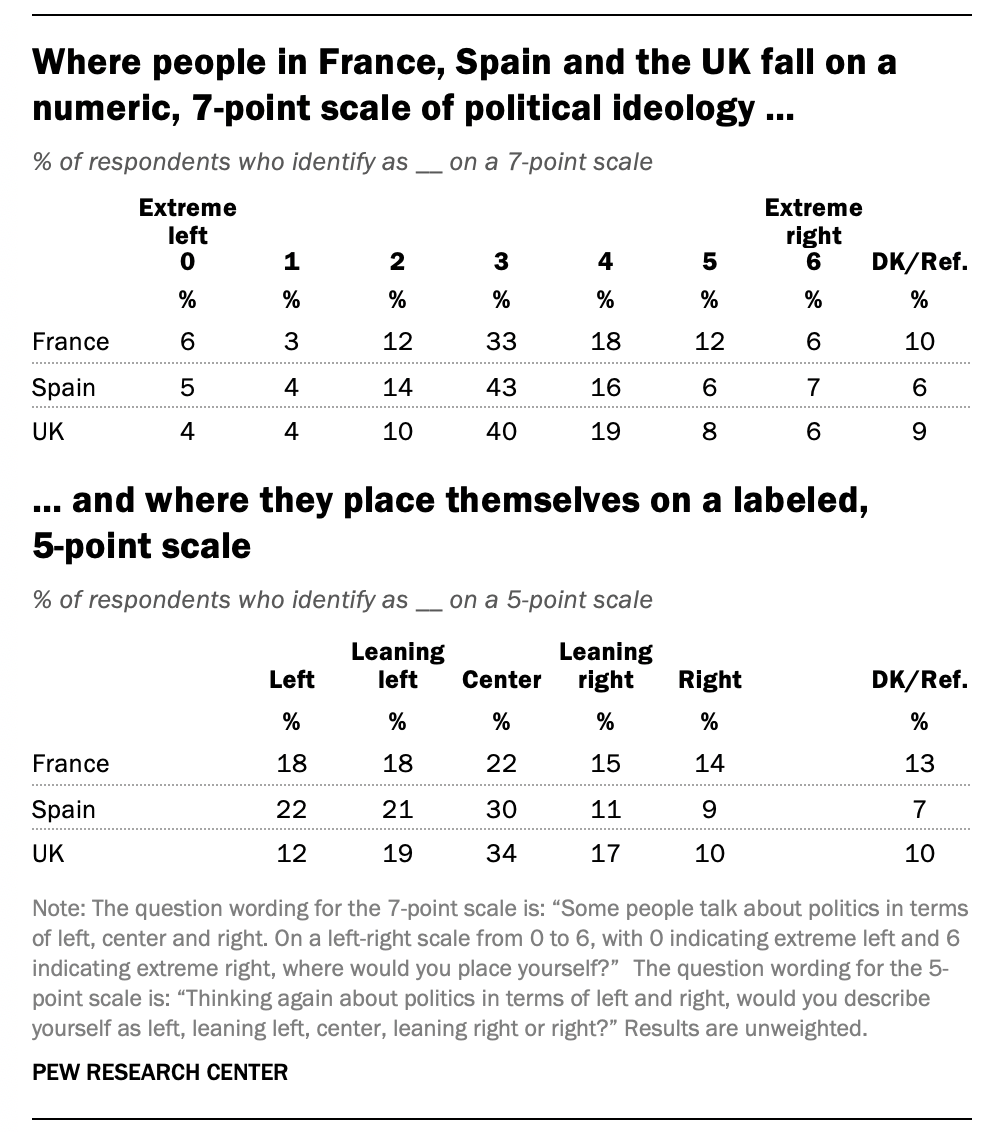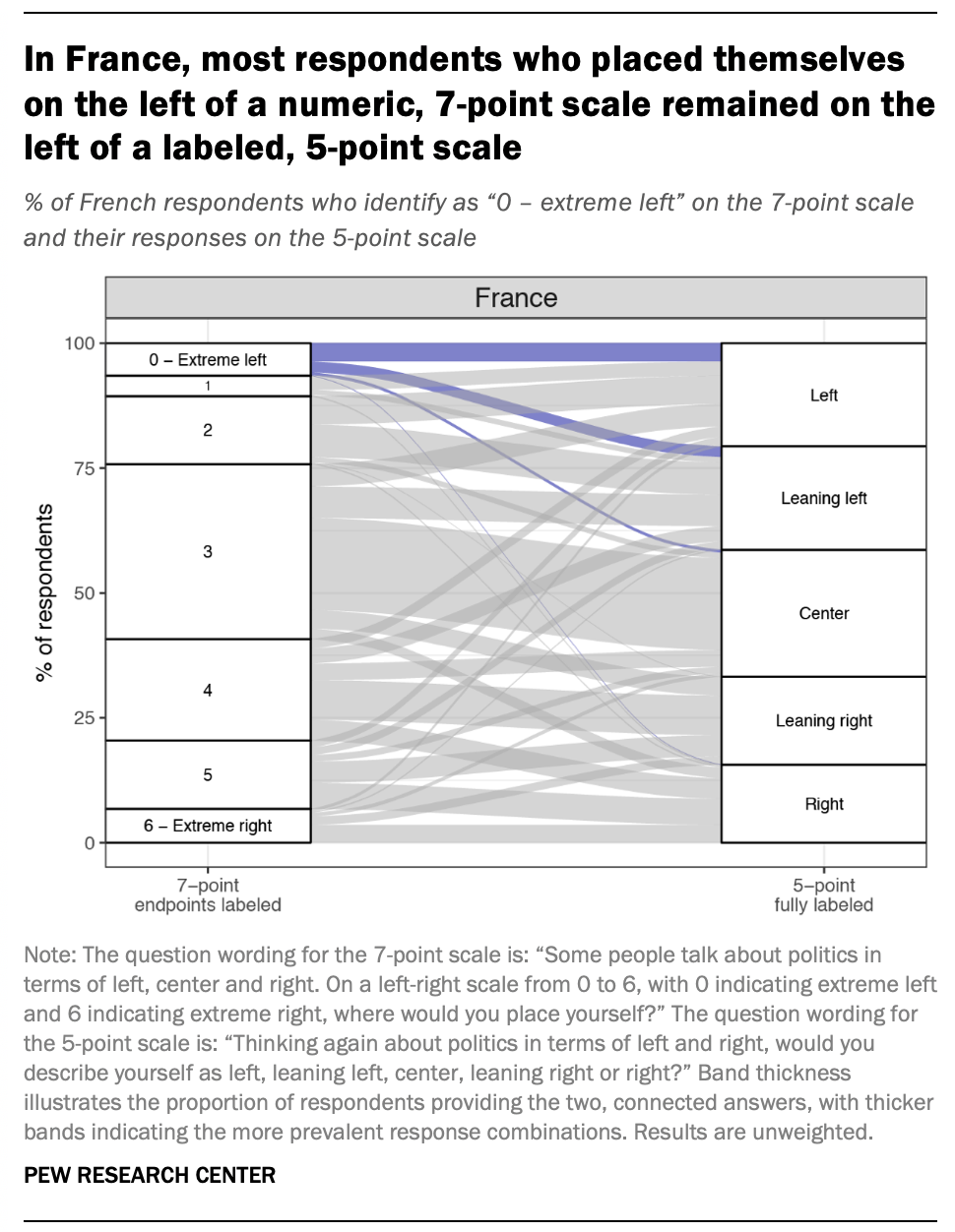(Related post: On a scale from 1 to 10, how much do the numbers used in survey scales really matter?)
(相关文章: 从1到10的量表,调查量表中使用的数字到底有多重要? )
At Pew Research Center, survey questions about respondents’ political ideology are among the most important measures in our comparative, cross-national surveys. Our recent research in Europe, for instance, explored how political polarization in the region shapes long-standing debates about domestic, social and economic policies.
在皮尤研究中心,关于受访者的政治思想的调查问题是我们的比较性跨国调查中最重要的指标之一。 例如,我们最近在欧洲进行的研究探讨了该地区的政治两极化如何形成有关国内,社会和经济政策的长期争论。
To measure political ideology, our international questionnaires typically ask respondents to place themselves on a 7-point scale with two labeled endpoints (or anchors) — “extreme left” and “extreme right” — along with numbers for all of the points in between. However, some research suggests that it’s easier for respondents to understand a fully labeled scale, one that includes descriptions for the interior points as well, such as “leaning left,” “leaning right,” or “center.” In this post, we’ll describe a survey experiment we conducted to find out if two approaches to measuring the same concept align with — or diverge from — each other.
为了衡量政治意识形态,我们的国际调查问卷通常要求受访者将自己置于7点制范围内,并带有两个标记的端点(或锚点)“极左”和“极右”,以及介于两者之间的所有点的数字。 但是, 一些研究表明,受访者更容易理解带有完整标签的量表,该量表还包含内部点的描述,例如“向左倾斜”,“向右倾斜”或“中心”。 在这篇文章中,我们将描述一个调查实验,以发现两种测量同一概念的方法是否相互兼容或相异。
发现一目了然 (Findings at a glance)
Our survey experiment was part of nationally representative telephone surveys we fielded in France, Spain and the United Kingdom in the spring of 2018. (You can read about an earlier experiment related to survey scales in this Decoded post.)
我们的调查实验是我们于2018年Spring在法国,西班牙和英国进行的全国代表性电话调查的一部分。(您可以在此解码后的帖子中了解有关调查规模的更早实验。)
The 2018 surveys asked about political ideology in two ways. First, midway through each interview, respondents were asked the Center’s standard ideology question using a 7-point numeric response scale with only the endpoints labeled. Then, after several more questions, respondents were asked to describe themselves using a fully labeled, 5-point scale.
2018年的调查以两种方式询问政治意识形态。 首先,在每次面谈的中途,使用7点数字回答量表(仅标出端点)向受访者询问中心的标准意识形态问题。 然后,在再问了几个问题后,要求受访者使用完全标记的5分制量表来描述自己。

Here are some of the trends we observed across all three countries:
以下是我们在所有三个国家/地区观察到的一些趋势:
· The most common response option for both scales was the midpoint, though a greater share of respondents chose the midpoint on the 7-point scale (“3”) than on the 5-point scale (“center”).
·两种量表上最常见的回答选项是中点,尽管更多的受访者选择了7点量表(“ 3”)而不是5点量表(“中心”)。
· More respondents identified as right of center on the 7-point scale but left of center on the 5-point scale.
·更多的受访者将其确定为以7分制为中心居中,但以5分制为中心居中。
· Respondents were more likely to choose the endpoints on the 5-point scale than on the 7-point scale, and this was especially true for those on the ideological left.
·受访者更有可能选择5点制的端点,而不是7点制的端点,对于意识形态左翼的人尤其如此。
· Levels of item nonresponse (either “don’t know” or refusal to answer) were similar using both approaches.
·使用两种方法,项目无响应的级别(“不知道”或拒绝回答)相似。
使用Sankey图仔细查看法国 (A closer look at France using Sankey diagrams)
These aggregate numbers don’t tell the whole story. Fortunately, we can go a step further with our experimental data. By asking all respondents to answer both versions of our ideology question, we can also see how each respondent answered — or “moved” — from one question to the other.
这些总数并不能说明全部情况。 幸运的是,我们可以进一步利用实验数据。 通过要求所有受访者回答我们意识形态问题的两个版本,我们还可以看到每个受访者如何从一个问题回答另一个问题。
To illustrate these patterns, we created Sankey diagrams for each country using the R package ggalluvial. These graphs are a type of flow diagram that illustrate the movement from one category to the next — in this case, from the 7-point scale to the 5-point version. The band thickness in Sankey diagrams indicates the number of people taking a particular path, with thicker bands showing the more common pathways between two points on our different scales. (We should note at the outset that this part of our analysis does not include respondents who answered “don’t know” or refused to respond. It is limited to the 2,625 respondents who answered both ideology questions, including 846 in France, 935 in Spain and 844 in the UK.)
为了说明这些模式,我们使用R包ggalluvial为每个国家/地区创建了Sankey图。 这些图是一种流程图,说明了从一个类别到下一个类别的移动-在这种情况下,是从7点刻度到5点刻度。 Sankey图表中的条带厚度表示沿着特定路径行驶的人数,条带越粗表示我们在不同尺度上的两个点之间的路径越常见。 (我们首先要注意的是,我们的这一部分分析不包括回答“不知道”或拒绝回答的受访者。仅限于回答这两个意识形态问题的2,625名受访者,包括法国的846名,法国的935名。西班牙和英国的844。)

In the graph on the left, we’ll focus on French respondents who answered “0 — Extreme left” on the ideology question using the 7-point scale. Of the 55 French respondents who reported “0 — Extreme left,” most of them (31) chose “left” when later asked to identify their political ideology using the 5-point scale. These respondents are represented by the highlighted horizontal line straight across the top of the chart.
在左侧的图表中,我们将重点关注使用7分制在意识形态问题上回答“ 0-极左”的法国受访者。 在55名法国受访者中,他们将“ 0 –极左”表示为“左”,其中大多数(31)在后来被要求使用5分制来确定其政治思想时选择了“左”。 这些受访者均由突出显示在图表顶部的水平线表示。
But what about the 24 other people in France who chose the “0 — Extreme left” option? These respondents are represented by three narrower bands that start at “0 — Extreme left” and then slide down and to the right in the chart. Overall, most of these respondents (18) chose “leaning left.” Far fewer moved to “center” (five respondents) or “right” (one respondent). None of the respondents who answered “0 — Extreme left” on the 7-point scale reported “leaning right” on the 5-point scale.
但是,法国的其他24个人选择了“ 0-极左”选项又如何呢? 这些受访者由三个较窄的带代表,从“ 0-极左”开始,然后在图表中向下和向右滑动。 总体而言,这些受访者中的大多数(18)选择了“向左倾斜”。 转移到“中心”(五个受访者)或“正确”(一个受访者)的人数更少。 在7分制中回答“ 0-极左”的受访者中没有一个在5分制中报告“向右倾斜”。
The full range of patterns between the two scales in France is provided in the next Sankey diagram, with the path of each combination of responses illustrated by a different color.
下一张Sankey图中提供了法国两个刻度之间的全部图案范围,每种响应组合的路径都用不同的颜色表示。

A few trends emerge in this graph:
该图显示了一些趋势:
· About half of the respondents (53%) who selected the midpoint on the 7-point scale also chose “center” on the 5-point scale, as illustrated by the thickest yellow band connecting “3” to “center.” Among those who chose the midpoint on the 7-point scale but did not choose “center” on the 5-point scale, roughly twice as many placed themselves left of center than right of center: 31% versus 17%.
·大约一半的受访者(53%)选择了7点制的中点,也选择了5点制的“中心”,如将“ 3”连接到“中心”的最粗的黄色带所示。 在选择了7分制中点但未选择5分制“中点”的人中,将自己置于中心点左侧的比例是中心点右侧的两倍:31%对17%。
· Nine-in-ten (90%) of those on the left of the 7-point scale identified as left of center on the 5-point scale as well, as illustrated by nearly all of the blue bands above the midpoint moving to either “left” or “leaning left.” Overall, 7% of those who characterized their ideology as left of center on the 7-point scale moved to “center” on the 5-point scale, while 3% moved to “leaning right” or “right.”
·7点标尺左侧的十分之九(90%)也在5点标尺上也标识为中心的左侧,如中点上方的几乎所有蓝色带向任一方向移动所示“向左”或“向左倾斜”。 总体上,在7点制中以意识形态为中心的人中有7%移至5点制中以“中心”为中心,而3%的人则以“向右倾斜”或“向右”移动。
· Around two-thirds of respondents (66%) who placed themselves on the right of the 7-point scale also chose “right” or “leaning right” on the 5-point scale. Surprisingly, more of those who identified as right of center on the 7-point scale identified as “left” or “leaning left” on the 5-point scale (21%) than moved to the center (13%). This is shown by the similarly sized orange and red paths heading to “left,” “leaning left,” and “center.”
·大约三分之二的受访者(66%)将自己置于7分制的右边,也选择了5分制的“对”或“倾斜对”。 令人惊讶的是,在7分制中被标识为中心右的人在5分制中被标识为“左”或“向左倾斜”(21%),而不是移到中心(13%)。 朝着“左”,“向左倾斜”和“中心”的大小相似的橙色和红色路径显示了这一点。
· Of the 35 possible response combinations between questions, no respondents in France answered “0 — Extreme left” on the 7-point scale and later identified as “leaning right” on the 5-point scale, or answered “1” and then identified as “center” or “leaning right.”
·在问题之间的35种可能的回答组合中,法国没有受访者在7分制中回答“ 0-极左”,后来在5分制中确定为“向右倾斜”,或者回答“ 1”,然后确定作为“中心”或“向右倾斜”。
实验的跨国结果 (Cross-national results from the experiment)
Sankey diagrams can also be helpful to illustrate and better understand cross-national patterns in our three selected countries. As the next chart shows, several of the broad trends we observed in France are apparent in Spain and the UK as well:
Sankey图还有助于说明和更好地理解我们三个选定国家中的跨国模式。 如下图所示,我们在法国观察到的一些广泛趋势在西班牙和英国也很明显:

Here’s a closer look at what’s happening in this chart:
以下是此图表中发生的情况的详细信息:
· Across all three countries, most respondents who chose the midpoint on the 7-point scale also chose “center” on the 5-point scale (53% in France, 52% in Spain and 59% in the UK). And just as in France, more people moved from the midpoint of the 7-point scale to left of center on the 5-point scale than moved to the right on the 5-point scale.
·在这三个国家中,大多数选择7分制中点的受访者也选择5分制“中点”(法国为53%,西班牙为52%,英国为59%)。 就像在法国一样,从5点标度的7点标度的中点移动到5点标度的中心左侧的人数多于5点标度的向右转移的人数。
· In all three countries, the overwhelming majority of those who placed themselves on the left of the 7-point scale also identified as left of center on the 5-point scale (90% in France, 94% in Spain and 89% in the UK).
·在这三个国家/地区中,绝大多数将自己置于7分制左侧的人也确定为5分制中央的左侧(法国为90%,西班牙为94%,西班牙为89%英国)。
· There is more variability among those who placed themselves on the right of the 7-point scale. While 66% of those on the ideological right in France also placed themselves on the right of the 5-point scale, the share who did so was lower in both Spain (52%) and the UK (61%). Respondents on the ideological right of the 7-point scale in Spain and the UK were more likely than their counterparts in France to move to the center on the 5-point scale (26% in Spain and 25% in the UK versus 13% in France).
·将自己置于7分制右边的人之间的差异更大。 尽管法国有66%的意识形态权利人也将自己置于5分制的权利,但西班牙(52%)和英国(61%)的比例均较低。 在西班牙和英国的7分制的思想右被访者认为自己在法国的同行更容易移动到西班牙在英国的5分制中心 (26%和25%比13%法国)。
· As was the case in France, a few combinations of responses were not found in Spain and the UK. No respondents in Spain answered “0 — Extreme left” and then “center” or “leaning right,” or, in another combination, “1” and then a right-of-center response. Similarly, in the UK, no respondents first answered “0 — Extreme left” or “1” and then “right.”
·与法国一样,西班牙和英国未发现一些回应组合。 西班牙没有受访者回答“ 0-极端偏左”,然后回答“居中”或“向右倾斜”,或者回答“ 1”再回答居中偏右。 同样,在英国,没有受访者首先回答“ 0-极端左”或“ 1”,然后回答“右”。
As illustrated in the Sankey diagrams, there is general ideological consistency at the individual respondent level between the two survey questions, with only a limited share of people in each country providing apparently contradictory answers. In fact, only 11 of our 2,625 respondents provided the opposite extremes to the two scales (“0-Extreme left” and right or “6-Extreme right” and left). The robustness of these measures across countries suggests that both items can be useful in estimating political ideology. Across countries, our respondents behaved similarly, but not exactly the same. This is reflected in the subtle variability in responses to these two questions that are seemingly measuring the same thing.
如桑基图所示,在两个调查问题之间,每个受访者在思想层面上都具有普遍的一致性,每个国家中只有有限的一部分人提供明显矛盾的答案。 实际上,在我们的2,625名受访者中,只有11个对两个量表(“ 0极左”和右或“ 6极右”和左 )给出了相反的极端。 各国这些措施的健全性表明,这两个项目都可用于估计政治意识形态。 在各个国家/地区,我们的受访者的行为相似,但并不完全相同。 这似乎反映了对似乎正在衡量同一事物的这两个问题的回答的细微差异。
结论性思想 (Concluding thoughts)
Both scales have benefits. A 5-point, fully labeled scale allows respondents to identify with a qualitative description of their political leaning, while a 7-point, endpoint labeled scale provides respondents with more choices to select a position closest to their political ideology. While the two survey questions are different in scale size and wording, respondents across countries answered them in similar patterns, giving us confidence in both when conducting cross-country comparisons.
两种规模都有好处。 5点,完全标记的量表使受访者能够定性地描述其政治倾向,而7点,最终标记的量表则为受访者提供了更多选择来选择最接近其政治意识形态的职位。 虽然这两个调查问题的规模和措词不同,但各国的受访者以相似的方式回答了这些问题,这使我们对进行跨国比较时的两个问题充满信心。
There are several caveats, however. The experiment relied on relatively small samples that limited our findings in a few ways. For example, we could not conduct robust analyses across all possible answer combinations because some were too infrequent and others nonexistent. And while some respondents answered with “don’t know” or refused to answer at all, the number of people who did so was relatively small, limiting our ability to draw inferences about this group.
但是,有几个警告。 实验依靠相对较小的样本,这些样本在某些方面限制了我们的发现。 例如,我们无法对所有可能的答案组合进行可靠的分析,因为其中一些频率太低而另一些频率不高。 尽管有些受访者回答“不知道”或根本拒绝回答,但这样做的人数相对较少,这限制了我们对这一群体进行推断的能力。
Aside from sample size, there are a few other issues we would consider expanding upon in future experiments. For instance, we did not rotate question order to examine whether replying to the first ideology question affected respondents’ answers to the second question or subsequent items. Also, we tested only two response scales, which means we could not assess the merits of other permutations, such as the results of a fully labeled, 7-point scale or a numeric, endpoint-labeled 5-point scale.
除了样本数量外,我们还将考虑在以后的实验中扩展其他一些问题。 例如,我们没有轮换问题顺序来检查对第一个意识形态问题的答复是否影响了受访者对第二个问题或后续项目的回答。 此外,我们仅测试了两个响应量表,这意味着我们无法评估其他排列的优劣,例如完全标记的7点量表或数字的端点标记的5点量表的结果。
Finally, the questions we tested weren’t equivalent. The Center’s standard political ideology question includes the words “extreme” (in the 7-point scale itself) and “center” (in the question stem), but this is not the case in the alternative 5-point scale and associated question. Additional experimental conditions — say, keeping the scale length the same but testing different wordings, or vice versa — would allow us to disentangle these effects.
最后,我们测试的问题并不相同。 中心的标准政治意识形态问题包括“极端”(在7点量表本身中)和“中心”(在问题词干中)两个词,但在另选5点量表和相关问题中则不是这种情况。 额外的实验条件(例如,保持标尺长度相同,但测试不同的措词,反之亦然)将使我们能够解开这些影响。
To dig deeper, it might be useful to look beyond the survey results. It’s possible some respondents were confused when we asked for their political ideology twice, so one way to explore the issue would be to incorporate cognitive interviewing in future experiments. This may help researchers better understand the meaning of survey questions, including questions that ask about the same underlying concept, from a respondent’s point of view.
要进行更深入的研究,可能需要超越调查结果。 当我们两次询问他们的政治意识形态时,有些受访者可能会感到困惑,因此探讨该问题的一种方法是将认知访谈纳入未来的实验中。 这可能有助于研究人员从受访者的角度更好地理解调查问题的含义,包括询问相同基础概念的问题。
In the meantime, we plan to use the data from this experiment to further study whether one of these ideology questions is a more accurate or valid measure than the other. Comparing each question with other items asked in our surveys — such as respondents’ political party affiliation or their opinions on highly politicized topics — would provide additional insights, with the help of Sankey diagrams to visualize the results.
同时,我们计划使用该实验中的数据进一步研究这些意识形态问题中的一个是否比另一个更准确或更有效。 将每个问题与我们调查中询问的其他项目(例如,受访者的政党隶属关系或他们对高度政治化的话题的看法)进行比较,将借助Sankey图表将结果可视化,从而提供更多的见解。
This post was written by Martha McRoy and Stacy Pancratz. Both are research methodologists focusing on international survey research methods at Pew Research Center.
该帖子由Martha McRoy和Stacy Pancratz撰写。 两位都是皮尤研究中心专注于国际调查研究方法的研究方法学家。
翻译自: https://medium.com/pew-research-center-decoded/small-changes-in-survey-scales-can-matter-when-measuring-political-ideology-in-europe-4a10d9a015c5
本文来自互联网用户投稿,该文观点仅代表作者本人,不代表本站立场。本站仅提供信息存储空间服务,不拥有所有权,不承担相关法律责任。如若转载,请注明出处:http://www.mzph.cn/news/389583.shtml
如若内容造成侵权/违法违规/事实不符,请联系多彩编程网进行投诉反馈email:809451989@qq.com,一经查实,立即删除!











方法源码解析(二))
)

python在anaconda安装opencv库及skimage库(scikit_image库)诸多问题解决办法)



)